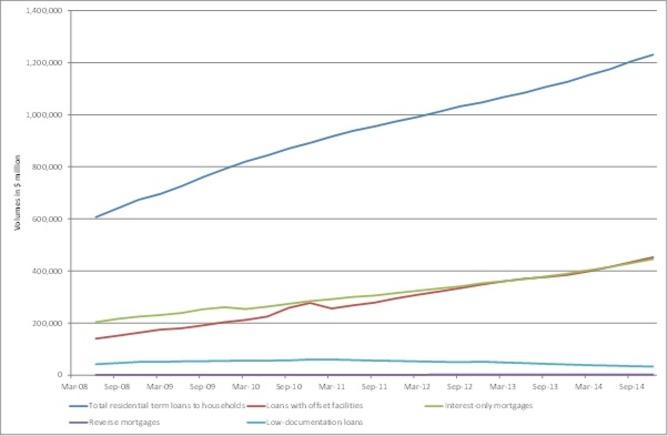Reverse mortgages are a way to release the equity in a home, which is an important component of wealth for many Australians.
Such mortgages have been proposed by the Financial System Inquiry as a way to support the dissipation of wealth by retirees and boost the efficiency of Australia’s financial system.
The following chart shows the stark increase in mortgage lending by Australian banks since the global financial crisis (GFC). Australian banks hold approximately A$1.3 trillion in mortgages.

Reverse mortgages have matched this growth in relative terms but remain at the margin, with a total exposure of A$2.9 billion (see the line at the bottom of the chart), far below standard mortgages and higher risk loans such as interest-only and low-documentation loans. Despite this growth in volume, the number of lenders has shrunk over time. According to the Financial System Inquiry, more than 15 lenders existed before the GFC but just five remain today.
Why are mortgages so popular and reverse mortgages not so, despite an ageing population with many billions of home equity waiting to be released?
How reverse mortgages work
A reverse mortgage allows homeowners to access a lump sum or an annuity, using their home as collateral. The benefit of reverse mortgages is that borrowers often continue to live in the property until they die. The decision to sell a house is often an emotional one and can be avoided with this product because the loan may be repaid from the sale of the house after death.
Reverse mortgages may also be used to fund outgoings or, in aged care, accommodation bonds that are typically in the hundreds of thousands of dollars.
Alternatives exist: Australians who wish to access home equity often prefer to sell the home and buy or rent a smaller one. This decision may trigger costs such as capital taxes and other fees but may also have merits, as retirees move into a home of the space and standard they require. Free cash may then be converted into annuities, funding a monthly income for instance.
How does a reverse mortgage differ from a standard mortgage?
In a reverse mortgage, the loan amount increases over time, up to a limit, as the borrower draws on the line of credit. The loan amount grows further as interest is added to the outstanding sum. As borrowers often have limited other assets and income with which to repay the loan, and if they enjoy a long life, the loan amount can quickly compound to unexpected levels.
To protect consumers (covered by the National Consumer Credit Protection Act), legal and financial advice via standardised calculators must be provided to customers for these products. In addition, banks provide a “no negative equity” guarantee, which means the loan amount cannot exceed the property’s value.
Finally, interest rates are generally higher than for standard home loan products due to less competition in this sector and higher risks for the lender. In this part of the market lenders tend to provide no more than 50% of a property’s value while standard mortgages tend to be around 80% of value - higher if mortgage insurance is used.
What are the risks for lenders?
The no negative equity guarantee may result in losses if loan amounts exceed property values. Despite generous collateral buffers, this can happen in a number of ways. First, home prices may fall. It is not unreasonable in financial markets to see drops equivalent to prior rises.
In addition, home owners have a right to live in the property and repayment occurs only after death. If a borrower enjoys a long life after taking out a reverse mortgage, or if the loan amount accrues at a higher rate than house prices the lender can be caught by the no-negative-equity guarantee. Longevity risk is very difficult to assess as it requires predicting life expectancy.
Longevity risk is also subject to adverse selection. Unlike in life insurance, it is healthy consumers who are likely to be keen on reverse mortgages.
In addition, the limited number of reverse mortgages makes it difficult for banks to do their risk analysis. Lenders condition the loan amount on the age of borrowers (the older, the larger the possible loan amount).
Borrowers also have prepayment options and may refinance and prepay a reverse mortgage if they find a cheaper lender, exposing the original lender to further risk.
Another aspect is that once the negative equity threshold is reached the borrower has no further financial incentive to maintain the property, which could result in a further depreciation of the property value.
How to promote home equity release
Home equity release is positive for the efficiency of the Australian economy and in line with our concept of retirement. In the US the government provides no-negative-equity guarantees to take some risk off the lenders and support this market.
The Australian government might not be prepared to indemnify the industry for risk. However, the development of such markets could be supported with more general measures.
Firstly, homes may be further recognised in the means test that determines the age pension. Such a measure may better match the needs of the population.
Secondly, a big industry concern is the limited availability of risk transfer solutions, such as derivatives and securitisation structures, which would allow banks to reduce both house price risk and longevity risk, at reasonable cost. It is difficult for banks to hedge or transfer longevity and house price risk. This is something of a catch-22 for the sector - only more equity release may lead to more risk transfer solutions and vice-versa
This article first appeared in The Conversation.

